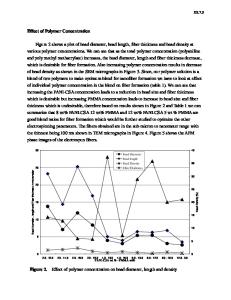Electrospinning of Nanofibers for Battery Applications
This book comprehensively discusses the basic principles and working mechanism of all kind of batteries towards clean energy storage devices. In addition, it focuses on the synthesis of various electrode materials with 1D architecture via electrospinning
- PDF / 8,933,138 Bytes
- 163 Pages / 453.543 x 683.15 pts Page_size
- 1 Downloads / 444 Views
Electrospinning of Nanofibers for Battery Applications
Electrospinning of Nanofibers for Battery Applications
Shengjie Peng P. Robert Ilango •
Electrospinning of Nanofibers for Battery Applications
123
Shengjie Peng Department of Applied Chemistry Nanjing University of Aeronautics and Astronautics Nanjing, China
P. Robert Ilango Department of Applied Chemistry Nanjing University of Aeronautics and Astronautics Nanjing, China
ISBN 978-981-15-1427-2 ISBN 978-981-15-1428-9 https://doi.org/10.1007/978-981-15-1428-9
(eBook)
© The Editor(s) (if applicable) and The Author(s), under exclusive license to Springer Nature Singapore Pte Ltd. 2020 This work is subject to copyright. All rights are solely and exclusively licensed by the Publisher, whether the whole or part of the material is concerned, specifically the rights of translation, reprinting, reuse of illustrations, recitation, broadcasting, reproduction on microfilms or in any other physical way, and transmission or information storage and retrieval, electronic adaptation, computer software, or by similar or dissimilar methodology now known or hereafter developed. The use of general descriptive names, registered names, trademarks, service marks, etc. in this publication does not imply, even in the absence of a specific statement, that such names are exempt from the relevant protective laws and regulations and therefore free for general use. The publisher, the authors and the editors are safe to assume that the advice and information in this book are believed to be true and accurate at the date of publication. Neither the publisher nor the authors or the editors give a warranty, expressed or implied, with respect to the material contained herein or for any errors or omissions that may have been made. The publisher remains neutral with regard to jurisdictional claims in published maps and institutional affiliations. This Springer imprint is published by the registered company Springer Nature Singapore Pte Ltd. The registered company address is: 152 Beach Road, #21-01/04 Gateway East, Singapore 189721, Singapore
Preface
At present, nanotechnology is offering new results and prospects to guarantee viable energy for the future on account of their unusual shapes, compositions, and physical/chemical properties. Remarkably, one-dimensional (1D) nanostructures, such as nanofibers, nanorods, and nanotubes, have drawn significant interest because of confinement effects and the structure-correlated properties. One-dimensional nanostructured material can be synthesized by using various techniques, including top-down synthesis and bottom-up method. Among them, electrospinning is an uncomplicated and versatile system which is used in generating 1D nanostructures. The prepared nanofibers can be scaled up for assembly on an industrial scale with tunable resulting characteristics like morphology and diameter. Interestingly, electrospun-based nanofibers deliver higher electrochemical performance for batteries, fuel cells, and supercapacitors. Though many reports have been published
Data Loading...











